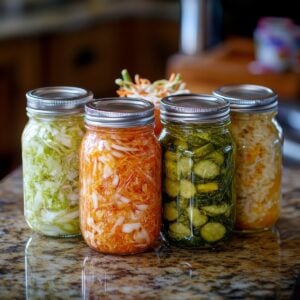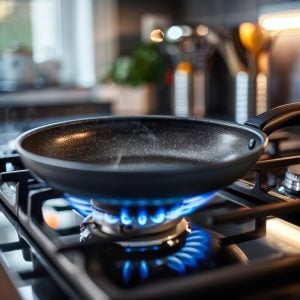Dazed and Confused: Smoke Point Versus Flash Point
A couple of days ago, I received a question from Carla regarding cooking oils. There are tons of oils out there that are suitable for cooking, but it can be unclear. I have certainly been confused, and Carla is, so I figured there would be other people out there equally confused. Here is Carla’s question:
I am so confused! I have checked several sites about “flash points” of oil, and they are different! I want to use the best for pan searing. I know you recommend canola, but I don’t have an oven-ready cast iron pan, so perhaps another oil that retains more heat is better? (Again, dazed and confused). Also, what heat do you keep the burner on ~ high?
If any of this sounds familiar, read on.
Generally speaking, the temperature we are most concerned with when using oils to transfer heat to our food is the smoke point. We’ve all been there—our oil is heating merrily in the pan, and then wisps of smoke begin rising from it, and it starts to smell funny. So, meet your oil’s smoke point.
Once the oil reaches the smoke point, it signals it is chemically breaking down. More critical for us cooks, that nasty smell translates into off-flavors in our food. If you have reached the smoke point, it’s time to concede defeat, get rid of that oil, and start again.
There is a problem, though. It’s all good to know what it means to reach the smoke point, but we also have to know what that temperature is to keep the oil from reaching it.
Fortunately, many helpful scientists have determined the smoke point for almost every oil known to man. Let’s all take a moment to thank the scientists. “Thank You, Scientists”
Low Smoke Point Oils
Unrefined oils, such as flax seed, walnut, and sesame, have very low smoke points – between 225°F and 350°F. Since these smoke points can easily be reached and exceeded even on medium heat, mainly when used in small amounts, unrefined oils are usually used for flavoring a dish or a dressing instead of as a cooking medium
Medium Smoke Point Oils
In the middle of the spectrum, oils such as grape seed oil, olive oil (not extra virgin) and peanut oil have smoke points between 375°F and 450°F. These oils can be dependably used for sautéing, pan frying and even deep frying. I especially like peanut oil for deep frying.
High Smoke Point Oils
If you are looking for oils with very high smoke points, you can’t go wrong with refined canola oil or ghee (or clarified butter) with smoke points between 470°F and 485°F.
Which One Should I Cook With?
It would be a simplification to tell you to use the oil with the highest smoke point for all your cooking, especially because sometimes we want the flavor that good olive oil or butter imparts to our food, even though they both have relatively low smoke points. In light of this, it is helpful to have a thermometer that you can use to measure and monitor the temperature of your oil.
Of course, while inserting a thermometer in the pan works great for deep-fat frying, it’s impossible to gauge the temperature of a very thin coating of oil in the bottom of a pan with a thermometer. So, when sautéing or pan-frying, the best way to judge the temperature of the oil is with your ears and your eyes.
Should I Keep the Burner On High

Carla asks if she should keep the burner on “high” all the time. As I’ve heard Emeril say before, there are knobs labeled from low to high on your stove for a reason. It is up to us to adjust the temperature either up or down to keep the oil at the right temperature for frying.
First, you should always heat the pan before adding the oil. Give your heavy-bottomed pan a good four or five minutes over medium-high heat to get good and hot. To test the pan, flick a little water into the pan. If it immediately boils and evaporates without skittering all over the pan, you’ve reached the right temperature. If the water skates around the inside of the pan, reduce the heat a bit or take the pan off the burner until the water immediately boils but no longer skitters around.
While this might sound simplistic, there is science behind it. We know that water boils at 212°F at sea level. So if the water drops sizzle and evaporate within a second or two, we can be relatively sure that the pan is hot enough to let your food brown – at least 320°F.
Heating the pan before adding the oil will also help keep the oil from burning. If you add oil to a cold pan, you risk the oil starting to break down before the pan is hot enough for cooking. By heating the pan first, the oil will heat quickly, and you can add your food almost immediately. Likewise, adding room-temperature food to a hot pan will lower the pan’s temperature.
Cook With Your Ears Too
Once the food is in the pan, listen to the sound it makes. You’re looking for an excellent, constant sizzling sound. The oil should also be bubbling merrily around the edges of the food. Adjust the heat if you don’t hear a sizzle and the oil isn’t bubbling. If you hear angry popping sounds and smoke, lower the heat and take the pan off the stove to give it a chance to cool a bit.
Please know that this will take some practice. It takes a while to train our ears and eyes to help us with cooking.
Low Smoke Point Oils For High Heat Sautéing
So, is there ever a reason to use oils with a low smoke point for high-heat sautéing?
The answer is a qualified “yes.” You can cheat a bit when sautéing. I personally love the flavors of lovely virgin olive oil and butter. The problem is that these fats have pretty low smoke points. The milk solids in the butter pull the smoke point way down. But, since sautéing calls for small pieces of food, they cook quickly. I can mix some oil with a higher smoke point and a bit of butter for sauté. I get great flavor and a quick dinner. Perfect!
This doesn’t mean some milk solids in the butter don’t brown. It just means they are “diluted” by adding some other oil, so their effect isn’t as apparent. Plus, the flavor of browned butter is quite nice.
To retain some nutty butter flavors without the risk of browning and burning the milk solids, consider making and using clarified butter or ghee. Removing the milk solids increases the smoke point from 350°F to 485°F.
Heavy Bottomed Pans
Now, regarding Carla’s question about not having cast iron and using a different oil: it’s true that I recommend canola oil for frying because of its relatively high smoke point. What I like about a cast iron pan is that, while it takes a while to heat up, it stays hot for a very long time. This can make it easier to maintain a constant temperature in the pan.
Remember how I said that adding food to a pan cools it down? Well, the effect is more dramatic the thinner and flimsier your pan is. A thin pan might heat up quickly, but it will also cool down very quickly.
The issue with this is that not only will it take longer for the temperature to rebound when you add food, but you will also end up with hot spots in the bottom of the pan that could lead to burned spots on your food. Ironically, burning food in a pan that cools down quickly is easier!
Using a heavy-bottomed pan helps minimize hot spots and increase heat retention. Cast iron is perfect for this. However, it is not the end of the world if you don’t have one. Look for a stainless steel pan with an aluminum or copper core.
Stainless steel is not a great heat conductor.” It heats slowly, but it is tough, and acidic foods don’t react with it. Encasing a great conductor, such as copper or aluminum, inside a not-so-great conductor, like stainless steel, gives you the best of both worlds. When shopping for cookware of this sort, purchase the heaviest kind you can afford because heavier means better heat retention.
I do recommend that you buy a cast iron skillet. These days, they come pre-seasoned so you can use them immediately, and they only improve with time. As a bonus, cast iron is relatively inexpensive. For example, my 12″ Lodge cast iron skillet cost me less than 20 bucks, and I use it constantly.
Simple Rules For Sautéing or Pan Searing
Remember this: it’s not the oil that needs to retain the heat; it’s the pan.
When sautéing or pan searing, remember these rules in this order:
- heat pan
- test pan
- add oil
- heat oil
- add food
- adjust stove to maintain temperature
What About Flash Points
The smoke point of oil is way different from the flash point. If your oil reaches the smoke point, it’s pretty much ruined, but it’s not dangerous if you pay attention. The flash point, on the other hand, is the point at which little flames start dancing on the surface of the oil. This occurs around 600°F.
While this sounds like an impossibly high temperature, once fat has reached its smoke point, it only takes a short time for it to reach the flash point. Therefore, you must pay close attention when cooking and never leave the stove.
If you see tiny flames from the oil, please immediately remove the pan from the heat source. Turning off the burner is not enough because burners take time to cool. The flames will go out on their own, but to be on the safe side, put the lid or some non-flammable cover over the pan to cut off the oxygen—a cookie sheet will work.
And Then There Is The Fire Point
The flash point is bad enough, but if you reach the fire point of about 700°F – you are in for some trouble. The fire point is where the vapors coming from the oil catch on fire rather explosively. Once you’ve reached the fire point, removing the pan from the heat is not enough. The fire is self-sustaining now.
Nevertheless, you’ll need to take care of it. Whatever you do, do NOT try to extinguish a grease fire with water – you will just spread the flames. Instead, turn off the heat, slide the pan off the burner, and cover the pan. If the fire is small, you can use baking soda to smother the flames. However, the best practice is to use a kitchen fire extinguisher rated for grease fires (Class B).
Please do not let this talk of flash and fire points keep you from sautéing or even deep frying. If you are vigilant, you can prevent problems from happening. After any cooking, make sure that you turn off the stove and move the cooking pan off the burner.
I know this is a lot of information, but once you understand the terms smoke point, flash point and fire point and learn how to keep your cooking fats under the smoke point, you will be more relaxed and clear.
















9 Responses
I’ve found this info about the smoke point, flash point, and fire point very interesting because I had an unforgettable experience while cooking canola oil for chips.
On an induction stove, looked away for too long and when I returned to the oil it had started to smoke badly. I immediately carefully removed the pan to take outside. After about 10 steps it ignited and had to put down onto a bench while on fire.
Quickly placed the lid for the pan on it and it quickly went out. However after a minute or two it reignited. This happened 3 times with a minute or two bewteen each time it ignited. Gave up after that and took it outside with the lid on it and left it there overnight!
I’m curious to why and how it kept reigniting and was hoping you might have an explanation
Hi Gerad,
Fire needs heat, oxygen and fuel to sustain itself. The oil is the fuel, the oil had sufficient heat. It probably set fire initially because you were introducing extra oxygen over it while you were moving it outside. You did the right thing by putting the lid on it as it smothered its oxygen supply. Removing the lid after only a few minutes was giving it back its oxygen supply. Your mistake was not letting the oil cool to well below fire point before removing the lid, 2 or 3 minutes is not good enough. If this ever happens again, put the lid on the pan and set it aside for many hours until it has cooled completely and then throw it away.
DO NOT USE IT FOR ANYTHING EVER AGAIN as I have heard that the fire point is now way below what it was before.
I hope I have answered your question, I learned this in Culinary School and I have also had fire training at my workplace several times. The only thing I cannot verify as correct is the part about the fire point being lower.
If you get it hot enough, the flash point of cooking oil could drop: the oil’s composition will change to some extent due to thermal cracking. I don’t know how long this process takes, but I believe it happens at around 350 C, which you could probably reach on an induction cooker.
I had a flash fire this past weekend, and luckily I knew to cover it as opposed to putting water on it. Many people do not know this. Pass the word. Grease fires will spread if you try to put them out with water! Even knowing this, I have been to the doctor twice this week due to the burns on my hand (2nd degree).
Thanks for this tip and so sorry to hear about your burn Beth.
when you’re putting out a grease fire normally happens around Thanksgiving or Christmas time in the oven when you’re cooking your turkey use baking soda or flour it will put it out the fastest and will keep you from getting burned
be careful with flour because if thrown and there is enough space between the flower grains, it will be a big puff of fire.
I have a non-contact thermometer which I use for checking grill temps, etc. I have a regular dial thermometer in the deep fat but it only goes to 400F. If the deep fat gets ovrheated, the non-contact thermometer (which goes to something like 800F quickly tells me how much trouble I’m in.
Non-contact thermometers are sold by most tool stores for around $20.
Hi guys. I found this blog researching oil flash points following a scary experience usjng a sizzler pan in my Ooni pizza oven last night. Having heated the pan to about 350°C I poured extra virgin olive oil onto it which immediately burst into flames! Which oils should I have used?
Kind regards
Brian…in France….with no eyebrows!